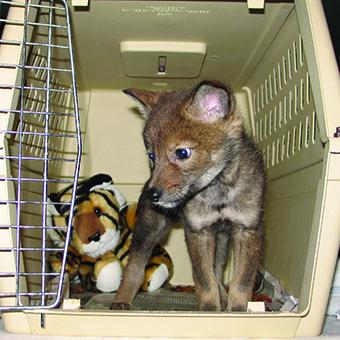
Why Did the Coyote Cross Bells Mill Road? He Probably Lives on the Other Side

Coyotes reside in every county in Pennsylvania, including Philadelphia. I have seen them on several occasions in areas around my house in Andorra. Coyotes live at the Jersey shore and even in Manhattan. But like wolves, coyotes get a lot of bad publicity.
Despite there being a year-round, 365-day bounty on coyotes, with no daily limit as to how many a hunter can kill, coyotes have managed to stay alive and to even expand their population. (Bounties have never been effective, but they still exist and hunters love them.) Coyotes are elusive and avoid people at all costs. Removal of wolves and mountain lions cleared the way for coyotes and with development and habitat loss, the coyote has had little choice but to adapt to urban and suburban areas.
The Eastern coyote is a seldom-seen canine. It rarely howls, unlike its Western cousin, who is noted for its bone-chilling songs. Coyotes also do a lot of “yipping” when communicating with each other. Eastern coyotes are much larger than their Western cousins, running 35-55 pounds, compared to 25-35 pounds for the Western coyote. Studies of DNA from Pennsylvania and New York animals show that the Eastern coyotes gained their superior size by interbreeding with wolves as they expanded their range around the Great Lakes. Their fur can be tan, red, blond or dark brown.
Coyotes are often mistaken for dogs or foxes. They are much larger than foxes but can look similar to dogs. The easiest way to make a quick determination is to look for the cylindrical, low-hanging tail that is tucked between the legs when running. Coyotes also have black lines running down the front leg, and their eyes are yellow.
Although they are listed as the state’s second-largest predatory animal (black bears being No. 1), coyotes are not a threat to people unless threatened or if defending their pups. They are rarely aggressive. They do prowl at night in search of food, and are opportunistic — one of the best eliminators of road kill available. Their favorite foods are mice, rabbits, squirrels, ducks and skunks. They can kill small dogs and cats (another reason to keep your pets inside). Coyotes seldom kill live deer, but may take fawns if food is scarce. Deer counts in Pennsylvania have not changed appreciably due to the increase and expansion of coyotes throughout the state. Unlike wolves, they do not hunt in packs, but will often be seen in pairs or family units.
I once had multiple coyotes howling outside the house where I was staying in West Cape May. They must have smelled the litter of kittens I had in the bedroom and who had been in the screened porch during the day. I’m not sure who was more scared, the kittens or me! The sound of those howls provoked a primordial response of fear the likes of which I had never experienced before. I knew it was irrational and that they were not going to hurt me, but I was spooked by their presence under my first-floor window.
A wildlife rehabber friend from Chester County told me about receiving a “puppy” that had been brought into the SPCA. Within a few days, it began to howl and alerted its caregivers that it was no dog. However, this coyote pup was otherwise little different from any other puppy. (It was legally transferred to a coyote rescue in New York so it would not lose its fear of humans.)
It may be their yellow eyes or the sound of their howls that have stoked the fear and hatred of coyotes that has existed throughout time. But coyotes are beautiful, intelligent, social creatures that do not enjoy death by bullets or crossbows or leghold traps. They are valuable even in the suburban ecosystem and do not deserve to be the targets of our blood sports. Tolerance and knowledge are the keys to living in harmony with coyotes, other wild animals and each other.
Brenda Malinics is a wildlife rehabilitator who runs Brenda’s Cat Rescue (brendascatrescue.com). Contact her at bmalinics@gmail.com.
